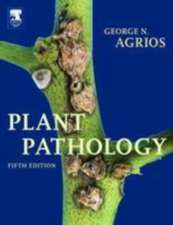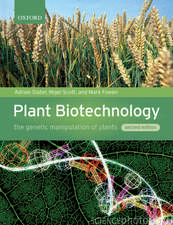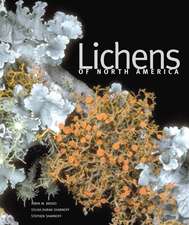Host-Pathogen Interactions in Plant Disease
Autor J. E. Vanderplanken Limba Engleză Hardback – 17 mar 1982
Preț: 433.65 lei
Preț vechi: 563.18 lei
-23% Nou
Puncte Express: 650
Preț estimativ în valută:
82.98€ • 86.87$ • 68.66£
82.98€ • 86.87$ • 68.66£
Carte tipărită la comandă
Livrare economică 05-19 aprilie
Preluare comenzi: 021 569.72.76
Specificații
ISBN-13: 9780127114200
ISBN-10: 0127114203
Pagini: 207
Dimensiuni: 152 x 229 x 16 mm
Greutate: 0.46 kg
Editura: ELSEVIER SCIENCE
ISBN-10: 0127114203
Pagini: 207
Dimensiuni: 152 x 229 x 16 mm
Greutate: 0.46 kg
Editura: ELSEVIER SCIENCE
Cuprins
Contents
Preface
1 Introduction
Text
2 Virulence Structure of Puccinia graminis Populations
2.1 Introduction
2.2 The Dissociation of Virulence for Genes Sr6 and Sr9d in Canada
2.3 The Association of Virulence for Genes Sr6 and Sr9d in the United States and Mexico
2.4 The Association and Dissociation of Virulence for Gene Sr9d, on the One Hand, and Genes Sr9a, Sr9b, or Sri5, on the Other
2.5 The Involvement of Dates and Temperature
2.6 Loss of Virulence Associations in Race 15B-1
2.7 The Dissociation of Virulence for Genes Sr6 and Sr9e
2.8 The Concept of Fitness
2.9 The Dissociation of Virulence for Gene Sr9e from Virulence for Genes Sr9a, Sr9b, and Sri15
2.10 Matching Virulence and the ABC-XYZ System
2.11 Genes Sr7b, SrlO, Srll, and SrTtl in the XYZ Group
2.12 Virulence Dissociation and Stabilizing Selection
2.13 Stabilizing Selection in Vertical Resistance
2.14 Stabilizing Selection and the Horizontal Resistance Equivalent
2.15 Stabilizing Selection Inhibiting Epidemics
2.16 The Second Gene-for-Gene Hypothesis
2.17 Breeding Wheat for Stem Rust Resistance
2.18 Multilines and Mixed Varieties
2.19 Possible Supergenes
2.20 Oat Stem Rust
2.21 Results with Some Other Pathogens
2.22 Some Conclusions
3 Races of Pathogens
3.1 Introduction
3.2 Additive and Multiplicative Increase
3.3 Genes and Taxa
3.4 The Ineptness of Fixed Races
3.5 Change as the Result of Gene Flow
3.6 Computerized Surveys
3.7 Discussion
4 The Influence of the Host
4.1 Introduction
4.2 Virus Diseases
4.3 Bacterial Diseases
4.4 Fungus Diseases
4.5 The Role of Mutations
4.6 Stabilizing Selection
4.7 Associated Virulence and Destabilizing Selection
4.8 An Illustrative Suggestion
4.9 Epistatic Interaction and Mathematical Models
4.10 Variable Mutation Rates
4.11 Genetic, Phenotypic, and Epidemiological Mutation
5 Host and Pathogen in a Two-Variable System
5.1 Introduction
5.2 The Geometric Illustration
5.3 Illustration by Analysis of Variance
5.4 Limitations of the Analysis of Variance Technique
5.5 Degrees of Freedom as a Limitation
5.6 Host and Pathogen Ranges as Limitations
5.7 Glossary
6 The Gene-for-Gene Hypothesis
6.1 Introduction
6.2 Biotrophy and Gene-for-Gene Systems
6.3 Possible Gene Duplication
6.4 Multiple Alleles with the Same Recognition System
6.5 Pseudoalleles with Different Recognition Systems
6.6 The Quadratic Check versus the Minimum Test for the Hypothesis
6.7 Susceptibility Is Specific
6.8 The Numerical and Chemical Implications of the Hypothesis
6.9 The Axenic Culture Fallacy
6.10 DNA
6.11 RNA
6.12 Protein
6.13 The Protein-for-Protein Hypothesis
6.14 Specific and Unspecific Receptors
6.15 Saccharides
6.16 Discussion
6.17 Ockham's Razor
7 Some Thermodynamic Background
7.1 Introduction
7.2 Free Energy, Enthalpy, Temperature, Entropy
7.3 Thermodynamic Clues
7.4 The Solvent Effect
7.5 A Possible Thermodynamic Sink
8 Continuously Variable Resistance to Disease
8.1 Introduction
8.2 The Polygene Model
8.3 Four Other Models
8.4 Polygenic Resistance versus Breeding for Resistance
8.5 The Error of Expecting Safety in Numbers
8.6 Experimental Evidence about Gene Numbers
8.7 The Central Role of Additive Variance
8.8 Additive Variance and Stable Resistance
8.9 Additive Resistance in Gains by Selection
8.10 Transgressive Segregation and Polygenic Resistance
8.11 Different Methods of Analyzing Variance
9 Epidemiology of Resistance to Disease
9.1 Introduction
9.2 Disease Progress Curves and Resistance
9.3 Slow Rusting and Incomplete Vertical Resistance
9.4 Horizontal Resistance That Delays the Start of an Epidemic
9.5 Resistance as Delayed Adult-Plant Susceptibility
9.6 Slow Rusting and Horizontal Resistance
9.7 The Ineptness of Some Infection Rate Averages
9.8 Testing for Resistance as Delayed Susceptibility
9.9 Young-Plant Susceptibility
9.10 Adult-Plant Resistance
10 The Anatomy of Epidemics
10.1 Introduction
10.2 The Logistic Equation Is Not a Model
10.3 The Background to Modeling
10.4 The Progeny/Parent Ratio in Reality
10.5 The Progeny/Parent Ratio in an Equation
10.6 The Effect of Dwindling Inoculum
10.7 The Role of the Latent Period
10.8 Epidemics with High Progeny/Parent Ratios
10.9 Epidemics with Low Progeny/Parent Ratios
10.10 The Threshold Condition for an Epidemic
10.11 A Varying Progeny/Parent Ratio
10.12 Internal Checks of Accuracy
10.13 Analysis versus Synthesis
10.14 Two Models: Plateaus and Peaks
10.15 Appendix about the Tables
11 The Spread of Disease
11.1 Introduction
11.2 Background
11.3 The Spread of Monocyclic Disease
11.4 The Spread of Poly cyclic Disease
11.5 The Rate of Spread of Fast Epidemics
11.6 Monocyclic and Poly cyclic Disease
11.7 The Effect of the Scatter of Disease on the Infection Rate
Bibliography
Index






